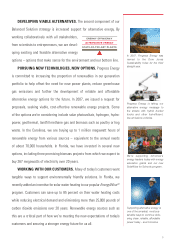Progress Energy 2007 Annual Report Download - page 21
Download and view the complete annual report
Please find page 21 of the 2007 Progress Energy annual report below. You can navigate through the pages in the report by either clicking on the pages listed below, or by using the keyword search tool below to find specific information within the annual report.
Progress Energy Annual Report 2007
19
The following Management’s Discussion and Analysis of
Financial Condition and Results of Operations (MD&A)
contains forward-looking statements that involve
estimates, projections, goals, forecasts, assumptions,
risks and uncertainties that could cause actual results
or outcomes to differ materially from those expressed
in the forward-looking statements. Please review “Safe
Harbor for Forward-Looking Statements” for a discussion
of the factors that may impact any such forward-looking
statements made herein. As used in this report, Progress
Energy, which includes Progress Energy, Inc. holding
company (the Parent) and its regulated and nonregulated
subsidiaries on a consolidated basis, is at times referred
to as “we,” “us” or “our.” Additionally, we may collectively
refer to our electric utility subsidiaries, Progress Energy
Carolinas and Progress Energy Florida, as the “Utilities.”
MD&A should be read in conjunction with the Progress
Energy Consolidated Financial Statements.
INTRODUCTION
Our reportable business segments and their primary
operations include:
•ProgressEnergyCarolinas(PEC)–primarilyengaged
in the generation, transmission, distribution and sale
of electricity in portions of North Carolina and South
Carolina; and
•ProgressEnergyFlorida(PEF)–primarilyengagedin
the generation, transmission, distribution and sale of
electricity in portions of Florida.
The “Corporate and Other” segment primarily includes
the operations of the Parent, Progress Energy Service
Company, LLC (PESC) and other miscellaneous nonregulated
businesses that do not separately meet the quantitative
requirements as a separate business segment.
Strategy
We are an integrated energy company primarily focused
on the end-use electricity markets. Over the last several
years we have reduced our business risk by exiting the
majority of our nonregulated businesses. Our two electric
utilities operate in regulated retail utility markets in the
southeastern United States and have access to robust
wholesale markets in the eastern United States, which
we believe positions us well for long-term growth. We are
focused on the following key priorities:
• consistentlyexcellinginthedailyfundamentalsofour
utility business, including safely and reliably generating
and delivering power to our customers;
• successfully implementing our balanced solution to
responsibly address demand growth and climate change;
• maintainingconstructiveregulatoryrelations;and
• achievingournancialobjectivesyearafteryear.
The Utilities operate in the southeastern United States,
one of the fastest-growing regions of the country, and
had a net increase of approximately 51,000 customers
over the past year. Despite our anticipated customer
growth, the Utilities are subject to economic fluctuations
and the corresponding impact on our customers,
including downturns in the housing and consumer
credit markets. Under normal weather conditions, we
anticipate approximately 1.5 percent to 2.0 percent
annual retail kilowatt-hour (kWh) sales growth at PEC
and approximately 2.0 percent to 2.5 percent annual retail
kWh sales growth at PEF in 2008. The Utilities seek a
mix of 80 percent retail and 20 percent wholesale. The
Utilities are focused on maintaining their regulated
wholesale business through targeted contract renewals
and origination opportunities.
We are implementing a comprehensive plan to meet the
anticipated demand in the Utilities’ service territories by
focusing on energy efficiency, alternative energy and
state-of-the-art power generation. First, we are enhancing
our demand-side management (DSM), energy-efficiency
and energy conservation programs. Recent legislation
in North Carolina and Florida provides recovery for
eligible costs of these programs. Second, we are
pursuing renewable and alternative energy to increase
the proportion of renewable and alternative energy
sources in our generation portfolio. Recent legislation
in North Carolina established a minimum renewable
energy portfolio standard beginning in 2012. Executive
orders issued by the governor of Florida address the
reduction of greenhouse gas emissions and may lead
to renewable energy standards in Florida. The Utilities
have requested proposals for alternative energy sources,
and options being considered include conversion of
waste (such as wood, scrap tires and landfill gas) to
energy, biomass as well as investments in solar and fuel
cell programs. Third, we are evaluating new generation
and fleet upgrades as we estimate that we will require
new baseload generation facilities at both PEC and PEF
toward the end of the next decade. We are evaluating
the best available options for new generation, including
advanced design nuclear technology, gas-fired combined
cycle and combustion turbines, and modernization of
existing coal plants to use clean coal technology. The
considerations that will factor into this decision include,
but are not limited to, construction costs, fuel diversity,
transmission and site availability, environmental impact,
the rate impact to customers and our ability to obtain
cost-effective financing.
MANAGEMENT’S DISCUSSION AND ANALYSIS
























